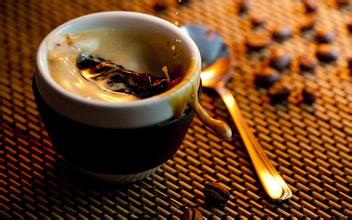Grinding scale Flavor description treatment of Cuban Crystal Mountain Coffee Bean Variety producing area
In Cuba, most of the coffee beans are picked by hand. Coffee beans are picked about every half a month during the ripening period. During or after picking, coffee beans are classified and those immature and bad beans are removed to ensure the quality of the coffee. Cubans usually deal with coffee beans in two ways-tanning and washing. Tanning is the simplest, cheapest and most traditional way to treat coffee, which is to let the coffee fruit dry in the sun but not ferment. The general drying time is about four weeks. The washing rule makes the aroma of fruit more into the coffee beans, thus adding a kind of coarse fruit aroma to the coffee.
Choose a good steam coffee maker (such as mocha pot), of course, the Italian Bilotti BRIKKA double valve mocha pot is even better.
Picture with Make Cuban Coffee Step 2 as its title
Choose Cuban-style Bustelo coffee or Pilon coffee. If you can't get pure Cuban coffee, you can use deep-roasted Colombian coffee instead.
Picture with Make Cuban Coffee Step 3 as its title
Mix raw coffee powder with crude sugar, do not use white sugar.
Picture with Make Cuban Coffee Step 4 as its title
Fill the bottom of the mocha pot with cold water.
Picture with Make Cuban Coffee Step 5 as its title
Put the metal filter at the bottom of the mocha pot and fill it with a mixture of coffee powder and crude sugar. You can load as much coffee powder and crude sugar as possible, as long as you don't press it too hard.
Picture with Make Cuban Coffee Step 6 as its title
Install the upper part of the mocha pot and tighten it.

Important Notice :
前街咖啡 FrontStreet Coffee has moved to new addredd:
FrontStreet Coffee Address: 315,Donghua East Road,GuangZhou
Tel:020 38364473
- Prev

Description of Grinding scale Flavor of Peruvian Coffee beans introduction of manor treatment in producing areas
Peruvian coffee beans are best known for their coffee beans from Chimacha Mayou in the middle and Cusco in the south. In addition, some areas in northern Peru also produce characteristic organic coffee. Organic coffee is made of beans grown in the shade of trees. Although the yield of coffee beans is not high because of the method of planting in the shade, its quality can reach the level of gourmet coffee. This is due to the ability to
- Next

Introduction to the description of the Flavor of Manor varieties in El Salvador Coffee Bean
Salvadoran coffee ranks side by side with Mexico and Guatemala as the producers of Asa and Merdo, and is fighting for the top one or two places in China and the United States with other countries. The highlands of origin are large coffee beans of all sizes, which are fragrant and mild in taste. Like Guatemala and Costa Rica, coffee in El Salvador is graded according to altitude. The higher the altitude, the better the coffee.
Related
- Detailed explanation of Jadeite planting Land in Panamanian Jadeite Manor introduction to the grading system of Jadeite competitive bidding, Red bid, Green bid and Rose Summer
- Story of Coffee planting in Brenka region of Costa Rica Stonehenge Manor anaerobic heavy honey treatment of flavor mouth
- What's on the barrel of Blue Mountain Coffee beans?
- Can American coffee also pull flowers? How to use hot American style to pull out a good-looking pattern?
- Can you make a cold extract with coffee beans? What is the right proportion for cold-extracted coffee formula?
- Indonesian PWN Gold Mandrine Coffee Origin Features Flavor How to Chong? Mandolin coffee is American.
- A brief introduction to the flavor characteristics of Brazilian yellow bourbon coffee beans
- What is the effect of different water quality on the flavor of cold-extracted coffee? What kind of water is best for brewing coffee?
- Why do you think of Rose Summer whenever you mention Panamanian coffee?
- Introduction to the characteristics of authentic blue mountain coffee bean producing areas? What is the CIB Coffee Authority in Jamaica?

